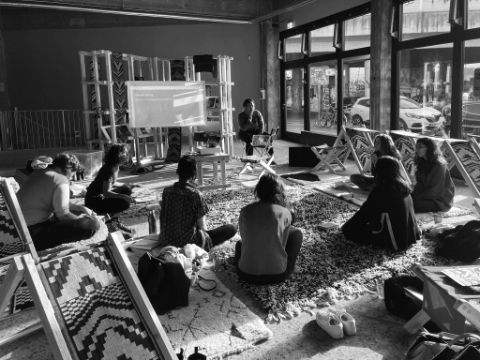Archive Ensemble
Leila Bencharnia, Omar Gabriel Delnevo, Chiara Figone, Gabriella Rebello Kolandra, Giordana Pieri, Vanessa Vieira

Archive Ensemble reimagines libraries as communal displays for collective interaction and various cultural formats based on anti-colonial and feminist thinking and practice. In the Haptic Library, Archive Ensemble creates a library as a social display of texts to sense, touch, and listen to—a collection of texturalities. Using readings, textiles, and music as multi-sensorial mediums for archiving and disseminating narratives and knowledges, the Haptic Library redirects its focus beyond the printed book and the western dominant sense of sight towards the sense of touch, inviting us to relate to knowledge from a plurality of materialities and modes of thought—involving carpets, fabrics, sonicities, and printed media. Against the ‘colonial library’ that accumulates knowledge produced by the Eurocentric gaze, as defined by Congolese philosopher Valentin-Yves Mudimbe, the Haptic Library instead features plural perspectives and forms of story-telling across regions, generations, and epistemologies. As a space, the Haptic Library offers hospitality for one’s own body in relation to a communal gathering. It includes various texturalities related to the research on the aesthetic and political genealogies of the O Quilombismo exhibition, such as publications from IPEAFRO (The Institute of Research and Afro- Brazilian Studies) founded by Abdias Nascimento in 1981 to practise the communitarian and affirmative philosophy of quilombismo.
HKW wishes to sincerely thank SAVVY.DOC for their collaboration.
Work in the exhibition: Haptic Library (2023), social display of texturalities (mixed materials) with readings, textiles, and sound, dimensions vary. Courtesy of Archive Ensemble